Departments
The University of Santo Tomas Faculty of Medicine and Surgery is highly committed to the education of future physicians, researchers, and academicians who are firmly grounded in the basic medical sciences and are providers of compassionate healthcare to their patients. These objectives are achieved through the Faculty’s outstanding roster of educators, whose national and international reputation for excellence in the filed of Medicine are unquestioned.
The Faculty is committed to training the next generation of physicians, as well as researchers and educators, to be competent, committed, and compassionate practitioners across a wide range of medical disciplines.
DEPARTMENTS
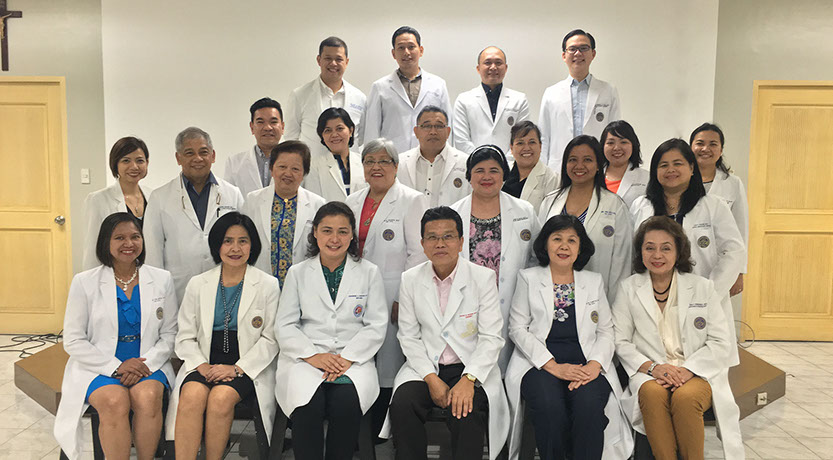
DEPARTMENT OF ANATOMY
Gross Anatomy
The course aims to enable the students to possess adequate knowledge of the normal form, size and structure as well as relationships of the different parts of the human body, comprehension of the relevance of structure to function and ability to apply the learned anatomical knowledge to disease entities. Teaching methodologies include orientation/briefing; discussion recitation; cadaver dissection; live video demonstration of prosected cadavers, computer –generated teaching aids and integrated case discussion. The course includes an 8-hour session in Gross Human Anatomy; 1-hour lecture in Clinical Anatomy and 1-hour lecture in Embryology or Genetics per week.
Histology
The course enables the students to gain knowledge in the developmental and functional approaches to morphology of the nervous system in correlation with clinical neurology, neuro-radiology, neuropathology and neuro-psychiatry. Lecture-projection, live video demonstration and discussion sessions alternating with the study of specimens of different sections of the brain and spinal cord comprise the main instructional strategy. Integrated case discussion including neuroanatomic learning issues enable students to apply knowledge in basic sciences to clinical material.
Neuroanatomy
The course enables the students to gain knowledge in the developmental and functional approaches to morphology of the nervous system in correlation with clinical neurology, neuro-radiology, neuropathology and neuro-psychiatry. Lecture-projection, live video demonstration and discussion sessions alternating with the study of specimens of different sections of the brain and spinal cord comprise the main instructional strategy. Integrated case discussion including neuroanatomic learning issues enable students to apply knowledge in basic sciences to clinical material.
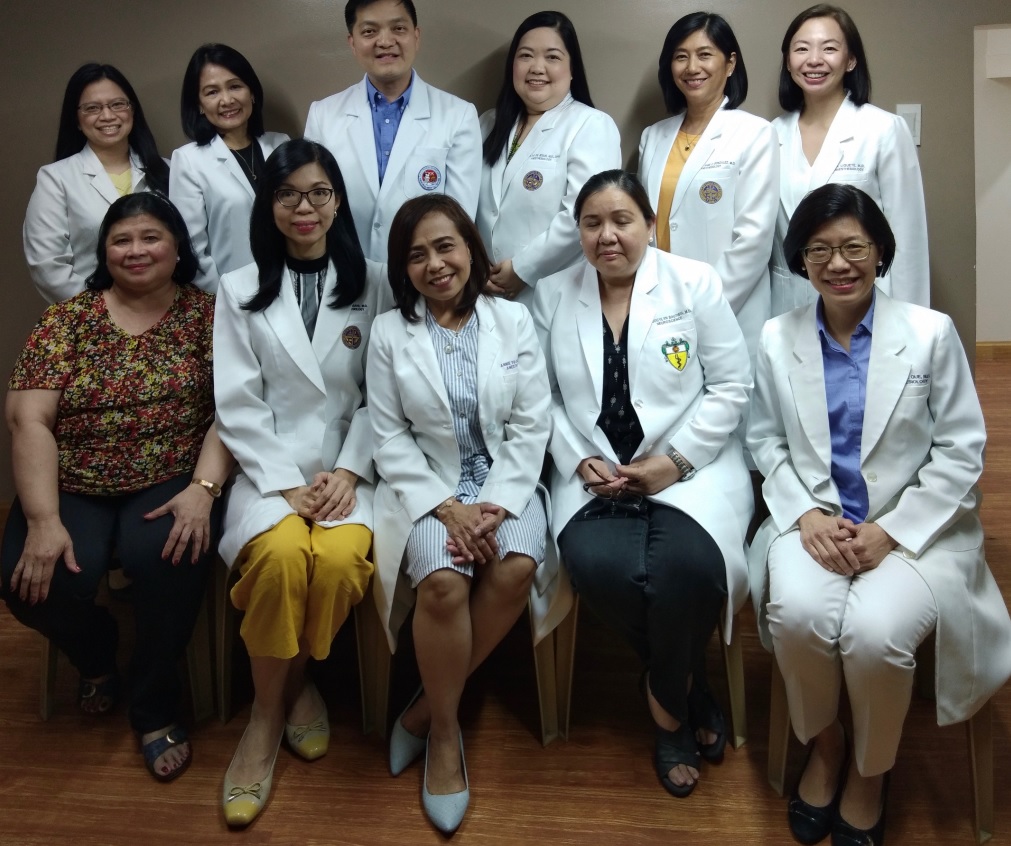
DEPARTMENT OF ANESTHESIOLOGY AND PERIOPERATIVE MEDICINE
Anesthesiology is taught to undergraduate medical students with the aim of providing a formal integrated program of instruction in Anesthesia and pain control, which they hopefully can apply later as doctors in regions where Anesthesiologists are non-existent.
Year I medical students learn basic principles of Anatomy, Physiology, Neuroanatomy and Biochemistry and integrate their knowledge with intubation, ventilation, resuscitation, peripheral nerve blocks for pain control and other forms of anesthetic management. Operational strategy is through integrated classroom didactic lectures included in the block system slots of Anatomy, Neuroanatomy, Physiology and Biochemistry departments.
Year II students learn the fundamental aspects of pain management, both acute and chronic. These include preoperative preparation, intraoperative and post operative pain control, general and regional anesthesia techniques, and pharmacology of intravenous, gaseous and volatile anesthetics, local anesthetics narcotics and non-narcotics drugs and other drugs used in anesthesia and pain control. Cancer and chronic non-cancer pain management, palliative care, life support and life saving measures are likewise included. These are done through interactive correlates, small group discussions and skills laboratory using phantoms and models given in the block system slots of Anesthesiology, Surgery and Pharmacology.
Year III and IV students gain knowledge and develop clinical competencies in pre-operative and intraoperative anesthetic management of patients. This is done through preceptorials, demonstration sessions and case discussions during conferences, given within the time allotted to Anesthesiology.
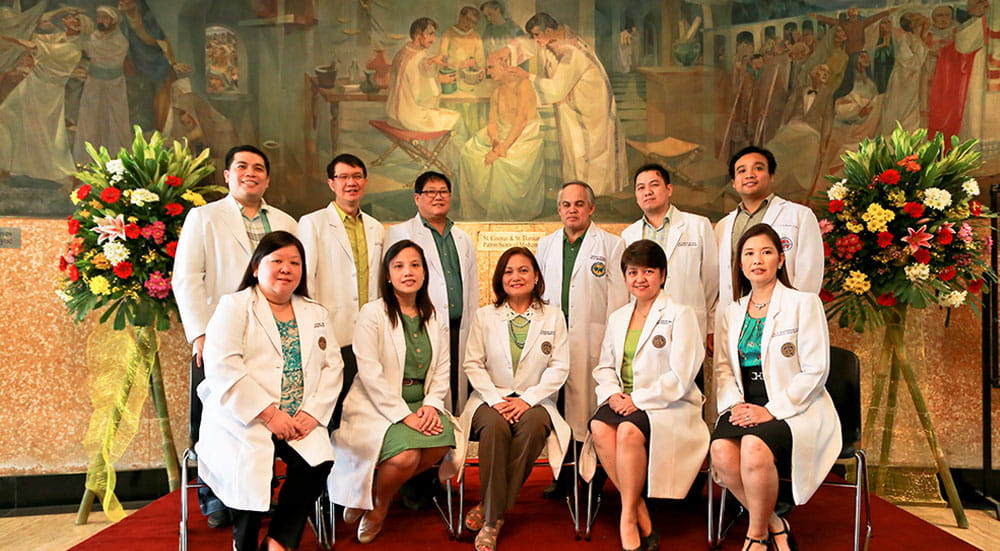
DEPARTMENT OF BIOCHEMISTRY
The yearly subject aims to provide students with a comprehensive working knowledge of basic Biochemistry including Molecular Biology and Basic Nutrition to facilitate their understanding of the molecular basis of diseases and subsequently enable them to relate Biochemistry to future clinical subjects in the medical curriculum.
The didactic portion in Biochemistry is divided into different blocks based on the different systems of the body and integrated with other disciplines like Physiology, Anatomy, Neuro-Anatomy and Histology.
There are eleven blocks for four shifting periods in the entire school year. They are namely: the Generalities, Gastrointestinal, Respiratory, Endocrine, Cardio-vascular, Hematopoietic, Renal, Molecular Biology, Special Senses, Specialized Tissues and Nutrition Blocks.
In the Generalities Block, chemistry and functions of carbohydrates, lipids, proteins and nucleic acids, enzyme kinetics and mechanisms and coenzymes are discussed. The Gastrointestinal Block deals with digestion of carbohydrates, proteins and lipids, energy metabolism, bioenergetics and biological oxidation.
Oxygen transport and storage, metabolism and toxicity, chemistries of hemoglobin, myoglobin, respiration and carbon dioxide transport are included in the Respiratory Module.
The Endocrine Block deals with introduction to metabolism, hormones – its classification and mechanisms, membrane receptors and signal transduction, metabolism of carbohydrates, proteins and lipids (fatty acids, triacylglycerol and ketone bodies metabolism).
The Cardio-vascular Block consists of cholesterol, eicosanoids, phosphoglycerides, sphingolipid and nitric oxide metabolism. Blood, its components, blood coagulation, red blood cell, heme and iron metabolism, the immunoglobulins and complement systems are dealt with in the Hematopoietic Block.
The Renal Block is made up of urine and kidney metabolism together with acid base and fluid electrolyte imbalance.
The Molecular Biology Block deals with gene expression and regulation and recombinant DNA technology.The topics that are included in the Special Senses and Specialized Tissues Blocks are eye metabolism and biochemistry of the connective tissue. The Nutrition Block gives us knowledge on basic nutrition and clinical correlation on selected topics in Biochemistry.
Laboratory experiments are conducted to augment the didactic concepts and encourage research activities. Problem sets, case discussions, journal researches in relation to the case discussions are regularly assigned to enhance student learning.
Medical Nutrition
The course aims to provide knowledge on the use of diet as an adjuvant therapeutic agent for earlier recovery of patients. Basic principles in diet therapy, dietary prescription writing, routine hospital and therapeutic diets for specific diseases are emphasized.
The course is taught through lectures and is given to the third year medical students one hour a week for one year. Subjects matters covered coincide with the different modules taken in Internal Medicine, Surgery and Pediatrics.
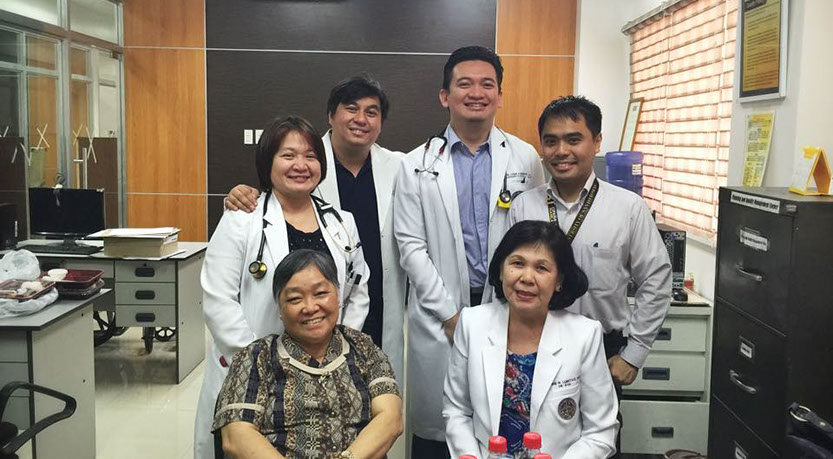
DEPARTMENT OF BIOETHICS
The course in Bioethics is designed to make the students sensitive to ethical problems in biomedical practice. It stimulates them as future physicians to develop mature moral reasoning and to act in accordance with principled moral judgment thereby developing the attitude of a competent and compassionate Catholic physician.
At the end of the program, the student should be able to identify and define the major bioethical concepts and principles; consistently apply these concepts in the analysis of bioethical problems; act in accordance with his moral judgment; demonstrate special solicitude to the sick and the poor and manifest justice and charity towards his colleagues, co-workers, patients and their families.
Teaching strategy consists of lectures, group discussions, seminars, role-playing, conferences with audio-visual aids, and other instructional devices.
Bioethics I
Basic Principles and AttitudesBioethics I focuses on bioethical principles, basic human attitudes and virtues, the ethics of human life, the ethics of sex and love, the Hippocratic Oath, medical codes of ethics, and the ethical code of Catholic Physicians.
Bioethics II
Healing and Caring for PatientsBioethics II deals with healing and caring for patients including ethical issues in the beginning of life which include contraception, sterilization, abortion, responsible motherhood, natural regulation of birth and reproductive technologies (e.g. in vitro fertilization and embryo transfer, artificial insemination, surrogate motherhood and cloning). Other difficult issues on death and dying, organ transplants and justice in the allocation of scarce resources, the human genome project, genetic manipulation, genetic engineering, pre-natal testing, genetic counseling and embryonic stem cell research are discussed.
Bioethics III
The Physician’s RelationshipBioethics III takes up the following relationships: physician and patient; physician-society; physician-physician; physician-nurse; physician-student; and above all, physician-patient relationship. It also focuses on rights of patients, human rights, bioethics committees and the role of physician in advocacy.
Bioethics IV
Clinical-Moral CasesFourth year students, or Medical Clerks, present clinical cases and analyze them from a medical and ethical perspective with the assistance of the teaching staff of the Department of Bioethics and some noted resource persons.
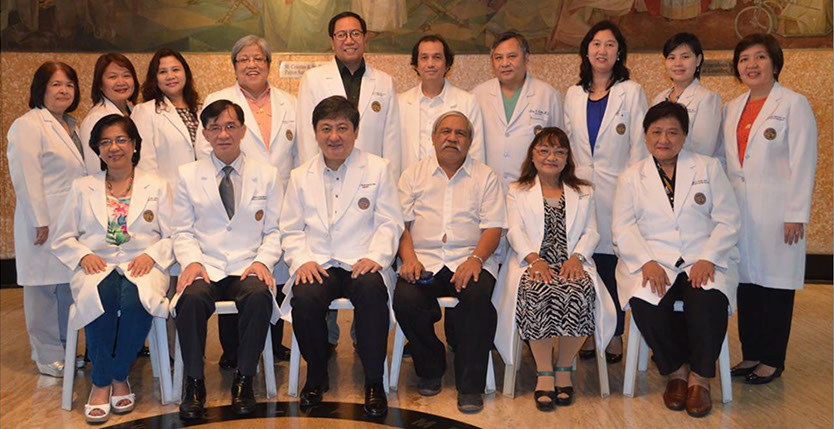
DEPARTMENT OF CLINICAL EPIDEMIOLOGY
This course gives proper knowledge and tools to students of Medicine on an emerging approach to medical management-Evidence Based Medicine (EBM). Corollary to this is a formal education in research so that future endeavors on this field, as demanded by most advanced stages in medical schooling and post graduate training, will be scientifically sound and, data generated by such are highly significant in current management of patients. In so doing, UST confirms its commitment to research activities, formally allocating assistance, resources and time exclusively for research.
The course involves all four (4) medical undergraduate years. Students will have formal classroom discussion and general lectures on research methodology, medical informatics, and critical appraisal of medical literature and evidence-based medicine in the first two school years of Medical school. Periodic evaluation of knowledge acquisition and progress is done and a required terminal output of a valid research protocol or proposal for Research Methodology and, properly appraised medical literatures in the four primary medical studies (diagnosis, therapy, harm and prognosis) for Critical Appraisal and Evidence- based Medicine. Separate consultation/ research laboratory hours will be allotted during the four medical school years to be used for: in the 1st year development, presentation, improvement and evaluation of research proposals; 2nd year & 3rd year research data gathering, encoding and analysis; 4th year research paper writing and presentation.
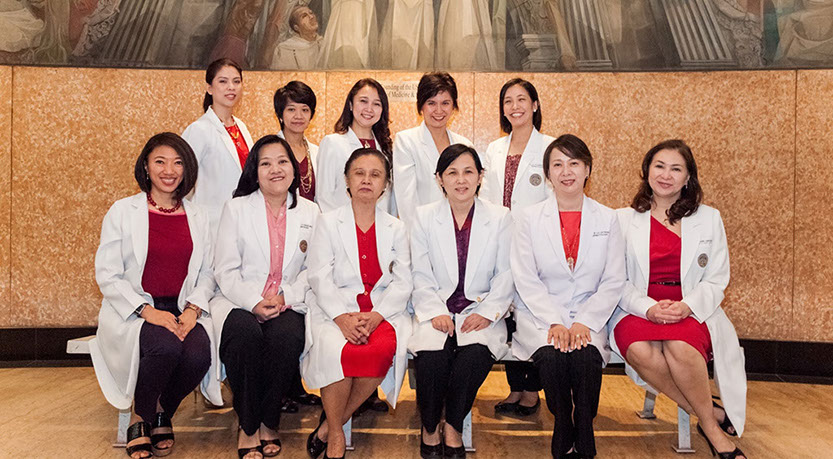
DEPARTMENT OF DERMATOLOGY
The course Dermatology 1, comprising 17 hours a semester, is included in the third year curriculum. It aims to impart to the students a basic knowledge of the most common skin diseases seen locally, through lectures and audio-visual correlation.
Clerkship in dermatology, a two-week rotation, is a formal exposure to patients seen at the Out-Patient Department and those admitted to the ward. Clerks participate in the evaluation and management of the OPD and ward cases with the teaching staff. Other activities lasting an hour each includes monthly basic and clinical science lecture and weekly Grand Rounds for the presentation of interesting cases, and Journal Club session.
The clerks also assist during minor dermatological procedures done at the Out-Patient Department.
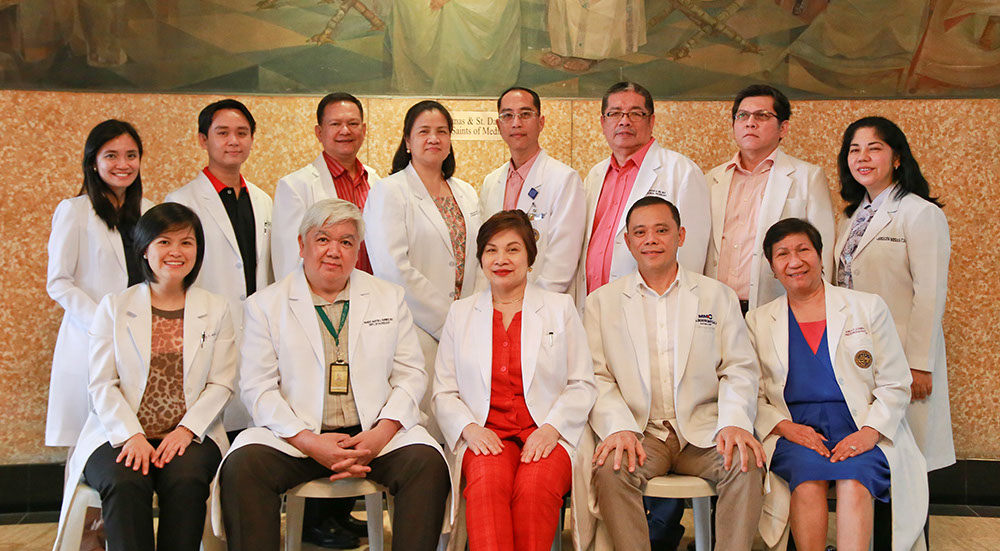
DEPARTMENT OF LABORATORY MEDICINE
Microbiology
The course focuses on both basic and medical microbiology. During the first semester, the students are expected to have an understanding of microbial bacteriology including food and water bacteriology. In the second semester, systemic mycology and virology are taught with small group tutorials on cases towards the end of the semester.
Teaching strategy includes correlates, small group tutorials and skills laboratory. Audio-visual aids and actual demonstration of organisms are shown to the students. The course is a yearly subject given to second year medical students, four hours a week (two hours lecture and two hours skills laboratory or small group tutorial) for a total of 136 hours.
Parasitology
The aim of the course is to enable the students to acquire basic knowledge of common parasitic diseases of man in the Philippines. The course includes the morphology, biology, life cycles and classification of parasites in man. It emphasizes the epidemiology, pathology, diagnosis and control of parasitic diseases in man.
Emphasis is placed on stages of parasites found in man which cause infection and give rise to symptoms or can be used to diagnose the infections. Correlation is made between stages of parasites commonly found in man and the symptoms elicited by the disease. Practical diagnostic procedures are mastered in the laboratory.
Teaching strategy includes correlates, small group tutorials, skills laboratory and projection and demonstration of parasites commonly found in the Philippines. The course is a semestral subject given to second year medical students, three hours a week for a total of 51 hours.
Clinical Pathology
The course aims to acquaint students with the scientific use of clinical laboratories (Hematology, Clinical Microscopy, Clinical Chemistry, Immunology, Blood Banking) as a basis for the understanding, diagnosis and treatment of diseases. Emphasis is made on selection and interpretation of laboratory tests used in the practice of medicine as well as on acquiring some understanding of the technology used in clinical laboratories.
Instructors are given in the form of correlates, small tutorials on cases, skills laboratory and demonstration of laboratory results.This is a semestral subject given to second year medical students, four hours a week for a total of 68 hours.
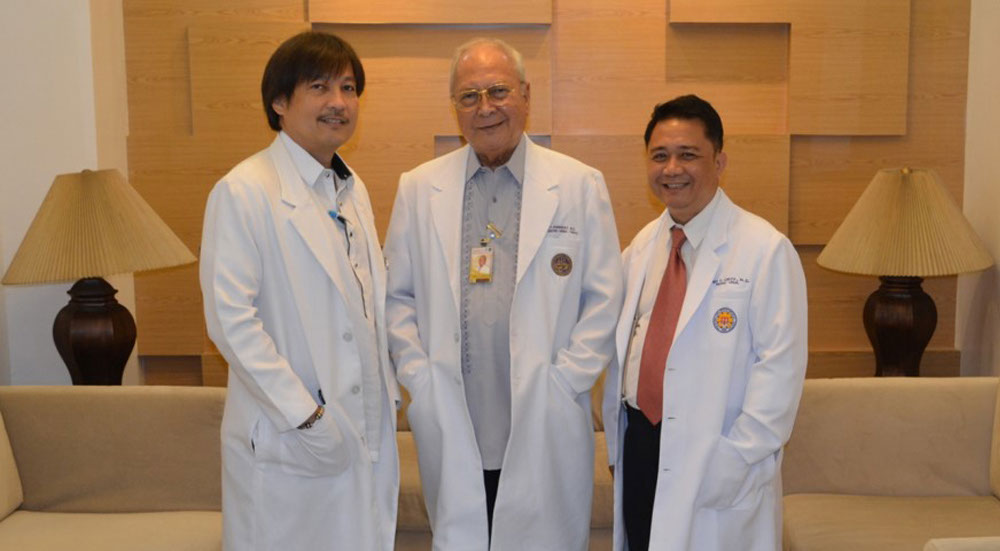
DEPARTMENT OF LEGAL MEDICINE
The course deals with the study of the medical aspects of law and legal aspects of medicine. It is given 3 hours a week for one semester for a total of 51 hours.
The terms forensic medicine and medical jurisprudence are often employed as synonymous. This practice has the sanction of long usage. However, these terms denote essentially different subjects that are closely related.
Forensic or legal medicine is concerned with the application of medical and paramedical scientific knowledge to certain branches of law, both civil and criminal. Its aim is to aid the administration of justice by correlating such knowledge and applying it to the purpose of law. Medical jurisprudence on the other hand denotes knowledge of law in relation to the practice of medicine. The subject deals with those relations which are generally recognized as having legal consequences. It is primarily concerned with legal rights and responsibilities of medical practitioners with particular reference to those arising from the doctor-patient relationship. It is advantageous for a medical practitioner to have acquaintance with the manner in which he may come in contact with the legal authorities and to have some knowledge of the legal procedure.
Forensic medicine is one of the most fascinating of all facets of the practice of medicine. It deals with topics such as injuries, assaults, poisoning, suspected criminal offenses, unnatural deaths and health laws. It is in great part an exercise in the study of other branches of medicine but viewed from a different angle. It assumes a medical practitioner’s knowledge of medical or scientific matters. The doctor or the scientist who by his practice holds himself out of to be proficient in the field is liable to be called upon to renders professional assistance of the most varied character in medico legal cases which may later compel his attendance at court. It is imperative therefore, that he should be well informed and alert to his medico-legal responsibilities, so as to discharge his duties in partnership with the law to the credit of his profession.

DEPARTMENT OF MEDICAL EDUCATION
The Department of Medical Education was organized in 1983 initially as the Committee of Medical Education in order to improve the curriculum. The following year it was created as a department. The Department is headed by a Chair and its members consist of faculty from different academic departments as approved by the Dean.
Its task is to oversee a relevant and updated undergraduate curriculum for the Faculty of Medicine and Surgery. Where necessary, it may search for, evaluate, propose, cause and coordinate the implementation of modifications and changes in the curriculum consistent with the mission and vision of the University medical school and where such modification will benefit the medical school’s graduates and prepare them for competent medical practice. Its concerns include not only monitoring of the curriculum content, teaching strategies and evaluation processes but also of faculty development programs. The department sets the guidelines on student promotion and administers the comprehensive examinations to all medical students, the Written Revalida to clerks, and the Medical Board Review Course. It also coordinates the clinical training and rotation of medical clerks and supervises the Oral Revalida in coordination with the Director of Clinical Programs.
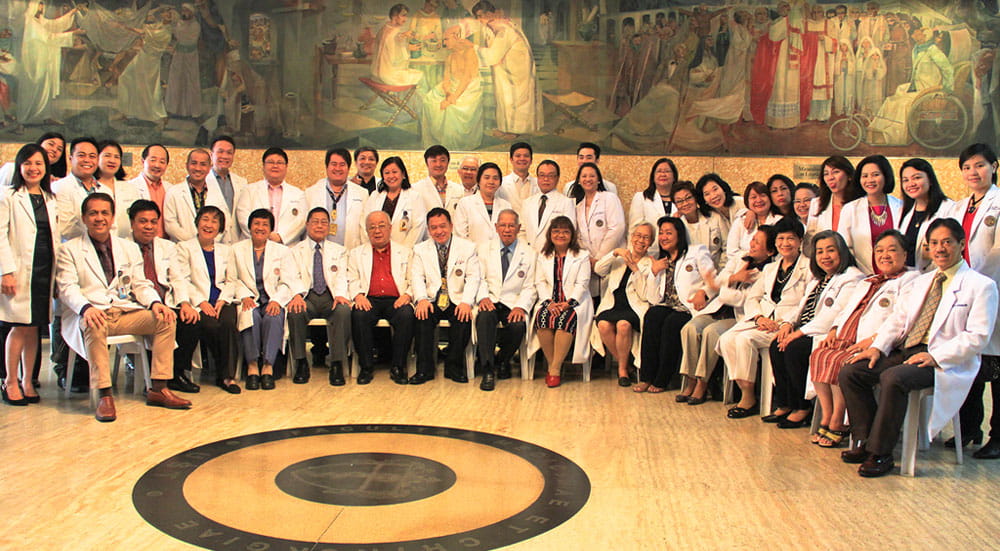
DEPARTMENT OF MEDICINE
The teaching of Medicine in the undergraduate years is one continuous program from the second to the fourth year. There are three stages in the program:
- Medicine I, Introduction to and essentials of Clinical Medicine, Second Year
- Medicine II, Problem-solving in Internal Medicine, Third Year
- Medicine III, Clinical Clerkship in Internal Medicine, Fourth Year
A thorough background in Anatomy, Physiology and Biochemistry in first year is a prerequisite to the study program, thereof integrating basic and clinical subjects in the various levels.
Medicine I (Introduction and Essentials of Clinical Medicine)
The focus of teaching is on the following: problem oriented history taking semiology, recognition and interpretation of clinical signs, education in the techniques of physical examination and in the use of common medical instruments in clinical diagnosis (stethoscope, sphygmomanometer, percussion hammer, ophthalmoscope, otoscope, tape measure, etc.).A satisfactory performance in a practical examination per semester is required to pass the subject. The program includes 2 hours of lecture and/or demonstration and 4 hours of decury class per week. Decury sessions are held in the hospital wards with active participation of the students with the faculty serving as facilitators. Student-faculty ratio is 10:1. Introduction to Clinical Medicine is an annual subject given 6 hours a week for a total of 204 hours.
Medicine II (Problem Solving in Internal Medicine)
The focus of teaching is on the following: a working knowledge of the natural history, clinical manifestations, diagnostic approach and principles of therapy of all diseases included in the list of minimum curricular requirements with emphasis on those commonly found in the Philippines. Knowledge acquired in Medicine I such as the problem oriented history taking, semiology, recognition and interpretation of clinical signs, education in the techniques of physical examination and the use of common medical instruments in clinical diagnosis are continued and reinforced. Satisfactory completion of Medicine I is a prerequisite to admission to the course.
Academic activities include 4 hours of lectures/seminars/case discussion and 6 hours of decury per week. Decury sessions are conducted in the hospital ward or outpatient service with the patient assignments for the student. Active participation of the student is a feature with the faculty serving as guide, facilitator and monitor of the students’ performance. Student-faculty ratio is 10:1.
Students are provided a systematic exposure to the following subspecialties (Hematology and Oncology, Gastroenterology, Infectious Tropical Diseases, Rheumatology, Cardiology, Pulmonology, Endocrinology and Nephrology) by quarterly rotation. An integrated problem-solving approach to actual cases is emphasized, likewise developing the attitude of self-learning among students.
Medicine III (Clinical Clerkship in Internal Medicine)
Clinical Clerkship is the third and final stage in the study of Medicine in the undergraduate curriculum. The activities include lectures, grand rounds, seminars and ward work through which he medical clerk is given maximal learning opportunities in the work-up and management of patients. They are required to be a part of a medical team serving patients from admission to discharge. They take histories, plan out a diagnostic and therapeutic regimen under the guidance of the medical intern, resident and consultant. As often as possible, they are given the opportunity to do diagnostic and therapeutic procedures under proper guidance. They are given training opportunities in decision-making. As part of their training in ambulatory medicine, they are given assignments in the emergency room and out-patient division.

DEPARTMENT OF NEUROSCIENCES AND BEHAVIORAL MEDICINE
Neurology
Clinical NeuroscienceThe subject aims to provide the students a smooth transition from the basic sciences (Neuroanatomy, Histology, Physiology and Biochemistry) to the clinical subjects. It introduces the students to the basic concepts of Neurology and Psychiatry in health and disease. Focus is on the pathophysiology, biochemical and morphological changes in the diseases of the Nervous System. The essentials of a thorough neurological evaluation and a systematic psychiatric interview and mental status examination are emphasized. The course is given to second year medical students for a total of 17 hours for one semester.
Clinical Neurology
The course emphasizes common neurological diseases such as cerebrovascular accidents, convulsive disorders, heredodegenerative diseases, toxic and metabolic disorders. Focus is also given to Tropical Neurology. Actual ward cases are illustrated and discussed. Ancillary diagnostic aids and the therapy of neurological disease are also discussed. The course is offered to third year medical students for a total of 51 hours per academic semester.
Clinical Clerkship in Neurology
Clinical clerks are given the opportunity for actual patient care in the ward under the guidance of Consultants, Residents and Interns working as a team. Theoretical neurology is thus translated into actual application.Clinical clerks participate in all teaching sessions of the Department of Neurology and Psychiatry. On Mondays, they discuss the problem-solving approach in Neurology; on Thursdays, they attend the Psychiatric Team Conferences; and on Fridays, they participate in a multidisciplinary approach during the Neurology-Neurosurgery-Pediatrics Seminars or Grand Rounds. A clinico-pathologic correlation during brain-cutting sessions is held every Wednesday. Clerks are assigned to the Neurology Ward for 7 days for a total of 60 hours of ward work, conferences, seminars and patient care.
Psychiatry I ( Introduction to Psychiatry)
This course focuses on the study of personality in all its aspects specifically on human development throughout the life cycle and the effects of the biopsychosocial factors in shaping personality; the neuroanatomic and neurophysiologic basis of behavior; and the psychodynamic concepts related to the development of the psyche. This course is given to first year medical students one hour a week for one semester or a total of 17 hours.
Psychiatry II ( Psychopathology)
The course deals with the study of the causes of mental illness and the various mental mechanisms utilized by the individual against anxiety. Emphasis is given to the psychopathological signs and symptoms of the different psychiatric disorders. Clinical examination of psychiatric patients puts a great deal of emphasis on interviewing techniques, history-taking and mental status examination. Finally, the student is introduced to the various diagnostic and ancillary tests used in psychiatry. The course is given to second year students for a total of 17 teaching hours.
Psychiatry III (Clinical Psychiatry)
The course is designed for the students to attain understanding of various clinical syndromes, ranging from mental retardation, acute and chronic brain syndromes, personality disorders, psychophysiologic autonomic nervous system disorders to the neuroses and functional psychoses. Various methods of management therapy are discussed not only in their principles but in their actual application. Emphasis is given to the role of Psychiatry in the various branches of medical disciplines such as Internal Medicine, Surgery, OB-Gyne, Pediatrics, EENT, etc. Forensic Psychiatry and Community are also studied. The DSM III Classification is adopted.The subject is given to the third year students for a total of 51 hours.
Clinical Clerkship in Psychiatry
Clinical clerks spend the whole day in the ward taking history, doing physical and psychiatric examinations of the patients, interviewing relatives concerned and participating in the actual treatment of patients under the guidance of both the attending and the resident physician.Clinical clerks are assigned to the Psychiatry Ward for a total of 7 days or 60 hours
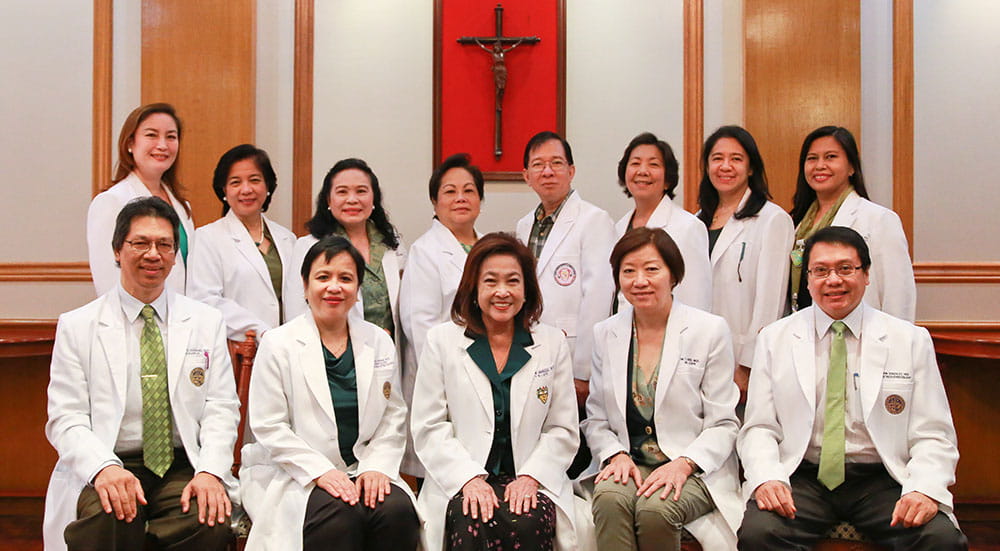
DEPARTMENT OF OBSTETRICS AND GYNECOLOGY
Obstetrics I
The course is offered for the study of normal Obstetrics. It encompasses the knowledge on basic anatomy and physiology of the reproductive tract; gametogenesis, placentation, fetal physiology, normal pregnancy, pre-natal care, labor, delivery and the puerperium. The course makes use of lectures, case discussions and audio-visual sessions as methods of teaching. The course is given to second year medical students for a total of 51 hours per semester.
Obstetrics II
The subject concentrates on the Pathologic aspect of Obstetrics that includes abnormalities of pregnancy, labor and puerperium, their prevention; diagnosis, management, abnormalities in the newborn and their prevention; family planning, operative obstetrics, their techniques and indications. The method of instruction is group discussion of cases given at the start of the semester. Supplemental lectures and demonstrations are conducted and augmented by audio-visual aids and special lectures on special topics. This is a semestral subject given to third year medical students for a total of 51 hours per semester.
Gynecology
The course is divided into sections which include anatomical defects of the female genital tract; disorders of pubertal development; inflammatory conditions; endocrinologic abnormalities; benign tumors of the genital tract; oncology; amenorrhea; infertility; and topics of special interest such as pelvic pain, cytology, genetics and human sexuality. The method of instruction is group discussion in the form of cases with some didactic lecture. The subject is given to third year medical students for a total of 51 hours per semester.
Obstetrics Clerkship Clinical
Clerkship in Obstetrics provides the students actual experiences and the practical application of the principles of Obstetrics. Consultants and the resident staff teach and guide them in assisting all procedures performed within the limit of the specialty. Procedures such as normal spontaneous delivery, episiotomy and repair, forceps extraction, curretage, caesarian section including total patient care are instructed and properly supervised. Activities in the service include teaching rounds with the consultants and resident staff, admitting and pre/post operative conferences with the Chairman and Chief of Section, mannequin demonstrations, seminars and journal reports, audio-visuals and pathology slide conference and out-patient follow ups. This is a 45 days rotation in the Department of Obstetrics both at the pay and clinical divisions of the hospital, and at the Fabella Hospital.
Gynecology Clerkship Clinical
Clerkship Clinical in Gynecology provides the students experiences in practical application of principles learned in didactic Gynecology. Training and guidance are provided to the students by the consultant and resident staff in these areas. Diagnostic procedures, management planning, Gynecology pathology review, problem-oriented recording, patient follow-up care, community involvement and interpersonal skills are emphasized.This is a 15 day rotation divided into conferences, ward rounds, 24-hour duties and out-patient services so that the student may attain the various goals of his Gynecology Clerkship.
DEPARTMENT OF OPHTHALMOLOGY
The UST FMS Department of Ophthalmology
Ophthalmology is comprehensively taught as a 2-part set of courses. The first is given as a semestral subject in Third Year. It equips medical students with knowledge on the diagnosis and management of eye diseases and basic eye care. The second course is a 2-week rotation in Clinical Clerkship (4th year) where students care for patients with eye diseases and rotate in the Ambulatory Care Services and Eye Institute of the UST Hospital. They also learn eye examination techniques, including slit-lamp examination and funduscopy. They are carefully guided by faculty, consultants, and resident staff Ophthalmologists who are specialists and subspecialists in the different fields of Ophthalmology.
Our goal is to prepare the students of the University of Santo Tomas Faculty of Medicine and Surgery, with the knowledge and examination skills required by a general medical practitioner to recognize what eye disorders can be treated without referral to an ophthalmologist, and how soon the other disorders should be referred to specialists. At the end of the course, the student will be able to evaluate a patient with an eye problem, formulate the appropriate diagnosis, recommend appropriate therapy with awareness of global norms in its management, and administer primary eye care. He will also be able to recognize eye findings with systemic implications and recommend appropriate action.
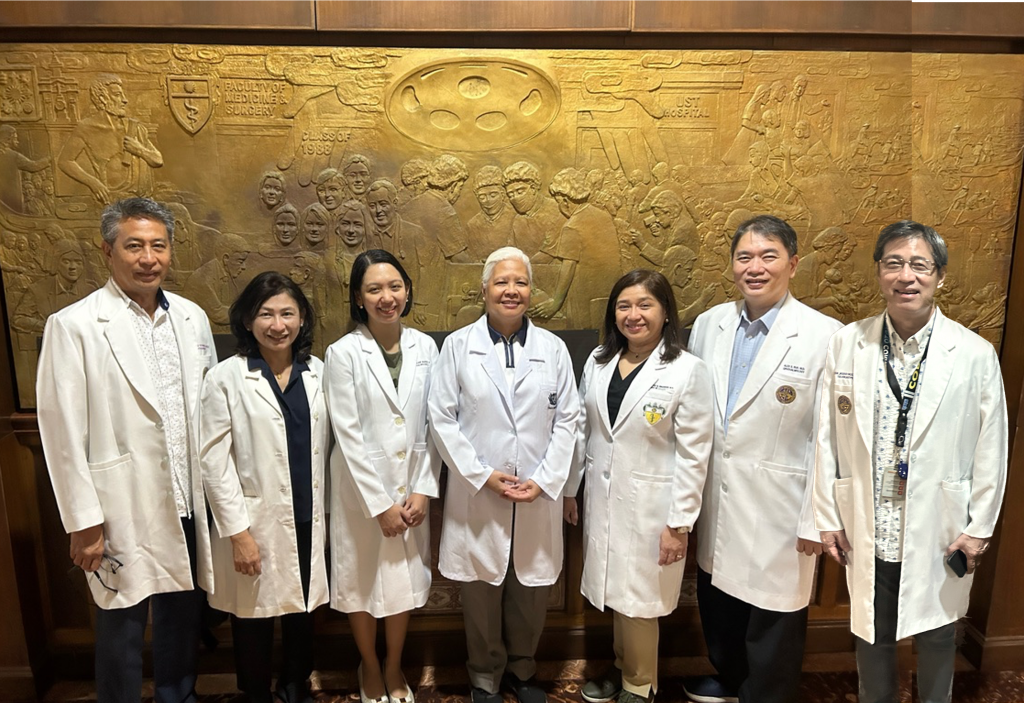
Left to Right: Ronald Yutangco MD, Susan L. Lim MD, Jacquline Mupas-Uy MD, Bernardita Navarro MD, Catherine Qui-Macaraig, MD, Alex Sua MD Marcel Banzon MD
Not in the Picture: Robert Uy MD
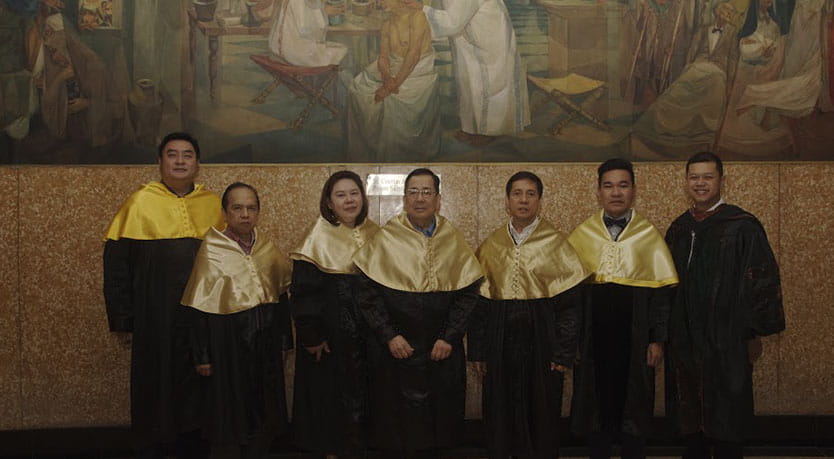
DEPARTMENT OF OTORHINOLARYNGOLOGY
The course aims to familiarize third year medical students with the common diseases of the ear, nose, throat, head and neck region in the local and international setting.
The course focuses on the current and scientifically proven armamentariums necessary in the prevention, diagnosis, management and rehabilitation of such diseases, responsive to the needs of various patients in different clinical and socio-cultural contexts.
Various teaching methodologies and strategies are utilized so that at the end of the course, the student will demonstrate the attributes of a self-directed learner and a critical thinker, which will prepare him in the life of a committed, compassionate and competent Thomasian physician.

DEPARTMENT OF OBSTETRICS AND GYNECOLOGY
Obstetrics I
The course is offered for the study of normal Obstetrics. It encompasses the knowledge on basic anatomy and physiology of the reproductive tract; gametogenesis, placentation, fetal physiology, normal pregnancy, pre-natal care, labor, delivery and the puerperium. The course makes use of lectures, case discussions and audio-visual sessions as methods of teaching. The course is given to second year medical students for a total of 51 hours per semester.
Obstetrics II
The subject concentrates on the Pathologic aspect of Obstetrics that includes abnormalities of pregnancy, labor and puerperium, their prevention; diagnosis, management, abnormalities in the newborn and their prevention; family planning, operative obstetrics, their techniques and indications. The method of instruction is group discussion of cases given at the start of the semester. Supplemental lectures and demonstrations are conducted and augmented by audio-visual aids and special lectures on special topics. This is a semestral subject given to third year medical students for a total of 51 hours per semester.
Gynecology
The course is divided into sections which include anatomical defects of the female genital tract; disorders of pubertal development; inflammatory conditions; endocrinologic abnormalities; benign tumors of the genital tract; oncology; amenorrhea; infertility; and topics of special interest such as pelvic pain, cytology, genetics and human sexuality. The method of instruction is group discussion in the form of cases with some didactic lecture. The subject is given to third year medical students for a total of 51 hours per semester.
Obstetrics Clerkship Clinical
Clerkship in Obstetrics provides the students actual experiences and the practical application of the principles of Obstetrics. Consultants and the resident staff teach and guide them in assisting all procedures performed within the limit of the specialty. Procedures such as normal spontaneous delivery, episiotomy and repair, forceps extraction, curretage, caesarian section including total patient care are instructed and properly supervised. Activities in the service include teaching rounds with the consultants and resident staff, admitting and pre/post operative conferences with the Chairman and Chief of Section, mannequin demonstrations, seminars and journal reports, audio-visuals and pathology slide conference and out-patient follow ups. This is a 45 days rotation in the Department of Obstetrics both at the pay and clinical divisions of the hospital, and at the Fabella Hospital.
Gynecology Clerkship Clinical
Clerkship Clinical in Gynecology provides the students experiences in practical application of principles learned in didactic Gynecology. Training and guidance are provided to the students by the consultant and resident staff in these areas. Diagnostic procedures, management planning, Gynecology pathology review, problem-oriented recording, patient follow-up care, community involvement and interpersonal skills are emphasized.This is a 15 day rotation divided into conferences, ward rounds, 24-hour duties and out-patient services so that the student may attain the various goals of his Gynecology Clerkship.
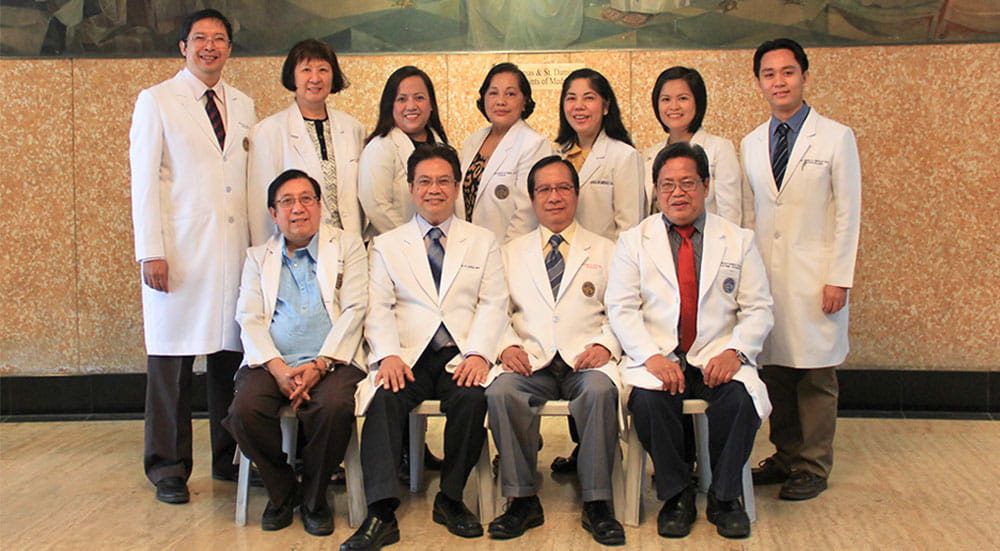
DEPARTMENT OF PATHOLOGY
Pathology is a basic discipline of Medicine which studies human diseases. It pertains to the study of the nature, course, cause, and mechanism of diseases with their structural and functional derangements.
General Pathology is a yearly subject with a total of 238 hours. The course basically includes Basic and Systemic Pathology, Postmortem examinations, Surgical Pathology (Histopathology), Cytology, Clinico-Pathologic Correlation and Basic Research. Methodology: Teaching strategies include general and special lectures, lecture-demonstration, laboratory sessions, small group discussion and clinico-pathologic conference.
The Department of Pathology is one of the most modern and most complete departments in its category in the country. The materials and equipment include autopsy materials, biopsy and cytology specimens, pathology library, slide set and microscope for each student, computerized audio-visual equipment and fully air-conditioned laboratory and lecture rooms.
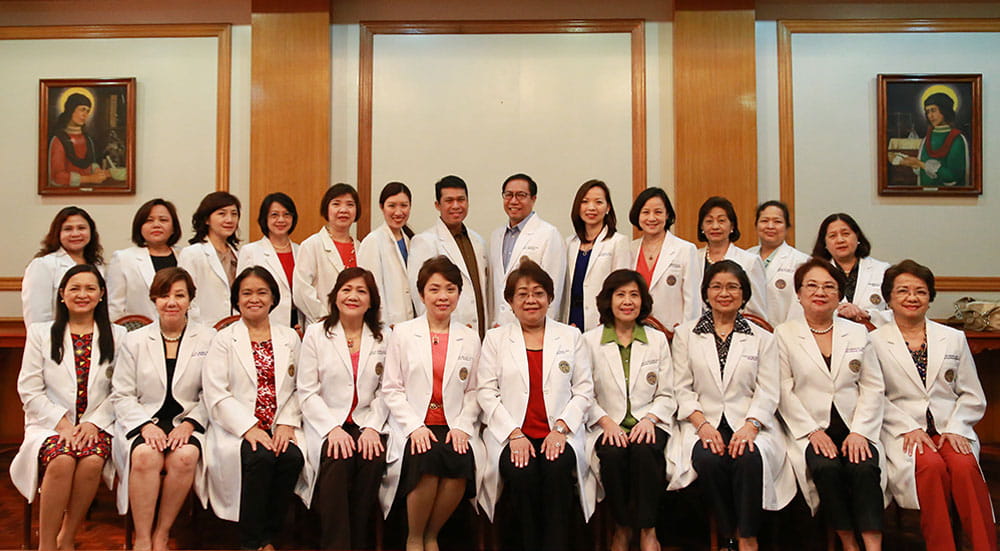
DEPARTMENT OF PEDIATRICS
Pediatrics I
The medical student is formally introduced to the field of Pediatrics in Pediatrics I. The course focuses on physiologic principles of growth and development from birth to adolescence. Preventive pediatrics with emphasis on the expanded program of immunization (EPI) is taken. Nutrition and infant feeding as well as growth monitoring are emphasized. A short course in physical diagnosis demonstrates the techniques in history taking and physical examination, and how these vary in the newborn infant through childhood and adolescence.To highlight these normal events in the child, some common problems in the newborn, the older child and the adolescent will be discussed. In this course, the student will realize that the health concerns of children differ from those of the adults and that the child’s response to illness varies with their age. Indeed, the child is not a miniature adult.Pediatrics I is a semestral subject with 34 hours. The course makes use of lecturettes/interactive lectures, small group discussion through case presentations, film showing, decury/skills laboratory and discussions on Pediatric study/research.
Pediatrics II
Pediatrics II is a yearly subject consisting of Didactic, Decury and Community Pediatrics. It is given a total of 170 hours.
Didactic Pediatrics comprises 102 hours or 60% of Pediatrics II. It is given 2 hours a week throughout the school year. It is divided into 4 modules consisting of 2 to 3 major subspecialties. The students are introduced to common and must-know diseases under these specialties. The teaching method is in the form of lectures, group discussions and grand rounds presentation.
Decury is given 34 hours or 20% of Pediatrics II. This course assigns students to clinical pediatrics in the form of decury sessions (practicum). Students are assigned cases in the pediatric ward or outpatient department. The art of history taking and physical examination in a child and basic pediatric procedures is reinforced. Teaching method includes lecture demonstration and return demonstration.
Community Pediatrics consists of 34 hours devoted to the exposure of the student to children and their family in an actual community. Each student is assigned a family in an underserved, disadvantaged community under the supervision of faculty members. These students are expected to help not only in the health supervision of the children but also in giving the entire family advice on all other aspects of the environment that may influence their health and well-being. This gives the student the opportunity to learn more about primary care, health education and home management of common pediatric emergencies. The students give immunizations (EPI), learn to manage upper respiratory infections and diarrhea with emphasis on oral rehydration therapy. They assess the nutritional state and monitor growth of infants, children and conduct mother’s classes on child care and health supervision.
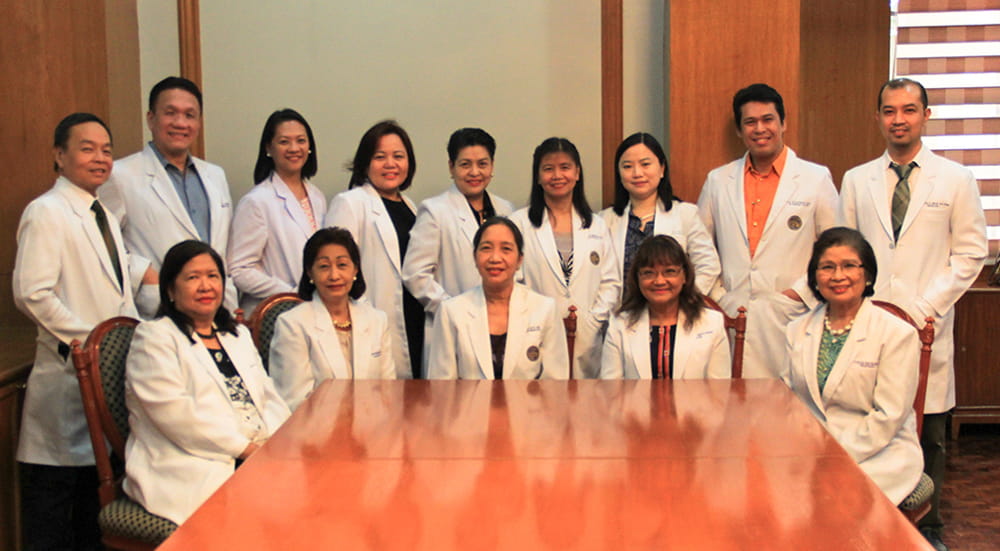
DEPARTMENT OF PHARMACOLOGY
Basic Pharmacology is a yearly subject given to second year students, 5 hours once a week for a total of 170 hours. The aim of the course is to enable the students to rationally use drugs in the prevention, diagnosis and treatment of human diseases, to rationally apply non-drug modes of prevention and treatment of human diseases and to develop awareness and gain basic skills in the investigative aspect of Pharmacology.
The course has three main activities, namely: didactic, laboratory and the student seminar/applied therapeutics / community work on drug utilization. The didactic part includes lectures and small group discussions on the basic concepts of pharmacology of the various classes of drugs classified according to therapeutic categories. The topics are synchronized as much as possible with those of other basic departments namely Medicine, Pathology and Laboratory Medicine. Emphasis is given to pharmacodynamics, pharmacokinetics, adverse effects and the therapeutic uses of each class of drug, making use of prototypes whenever possible. At the end of the session, the students practice prescription writing on the topic under study, making use of simulated cases. In all the discussions, the international non-propriety name (INN) is utilized and special emphasis is given on the drugs belonging to the “core list” of the current edition of the Philippine National Drug Formulary (PNDF).
The laboratory experiments are designed for 4-5 hour sessions and are aimed at developing in the students the ability to design experiments using indigenous medicinal plants as well as the ability to make accurate observations, gather data and to use appropriate statistical analysis to arrive at statistically valid conclusions.
For the students seminars, the students are assigned by teams to research on specific seminar topics, the output of which the students present in a conference attended by the other students and their respective faculty staff. Other student groups are assigned to study and analyze the actual therapy given to specific selected cases in the ward, emphasizing the rational use of drugs.
Another activity of the students in Pharmacology is the community work in selected barangays to study drug utilization patterns on common primary health care problems e.g. diarrhea, cough and colds, high blood pressure, etc. The students are asked to design their own research protocol, the results of which are presented to the class in the presence of the facilitators.
Clinical Pharmacology is given to the fourth year students handled by Pharmacology Faculty Staff members in the Clinical Department. 1-2 hours/week, during their rotation through Clinical Clerkship under the major departments at the UST hospital (USTH). During these sessions, the basic concepts and principles of Pharmacology are applied to clinical situations, real or simulated, preferably the former. The sessions are aimed at developing a firm understanding of the core knowledge, skills and attitudes that enable the medical graduates to practice rational therapeutics. The principles of problem-based pharmacotherapy are applied in all cases.
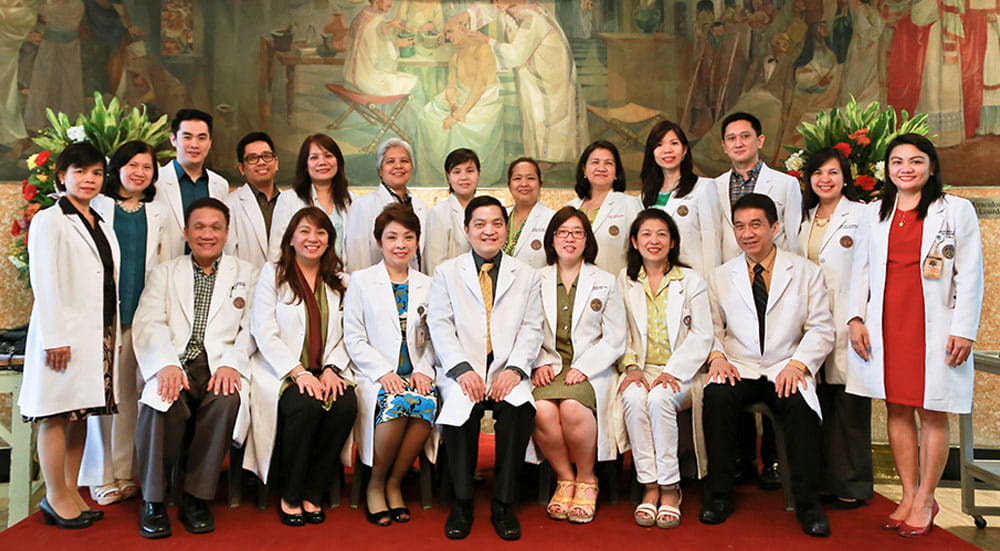
DEPARTMENT OF PHYSIOLOGY
The course aims to make the students understand the normal functions of the different organ systems of the body, the pathophysiologic mechanisms of diseases usually seen in the community and the physiologic principles involved in the treatment of these diseases. It also aims to develop attitudes and values essential for a primary health care physician and the ability to do problem solving and critical analysis using the data from case studies, laboratory experiments, and research projects.
Basically, the course includes the study of the physiology of the cell and the nervous system, the cardiovascular system, blood and immunity, respiratory system, renal fluid electrolyte and acid-base balance, the gastrointestinal system and the endocrine system. Special topics like sports physiology, fetal and neonatal physiology, aviation, space and underwater physiology, and physiology of aging.
Learning activities consist of lectures, class discussions, readings, laboratory work, data evaluation, sessions and laboratory conferences, student seminar reports, case discussion, film projections and research projects.
The students are evaluated on the basis of their performance in written exams, class discussion, laboratory activities and laboratory conferences, seminars, research, and case discussions.The course is a yearly subject given to first year medical students eight hours a week for a total of 272 hours.
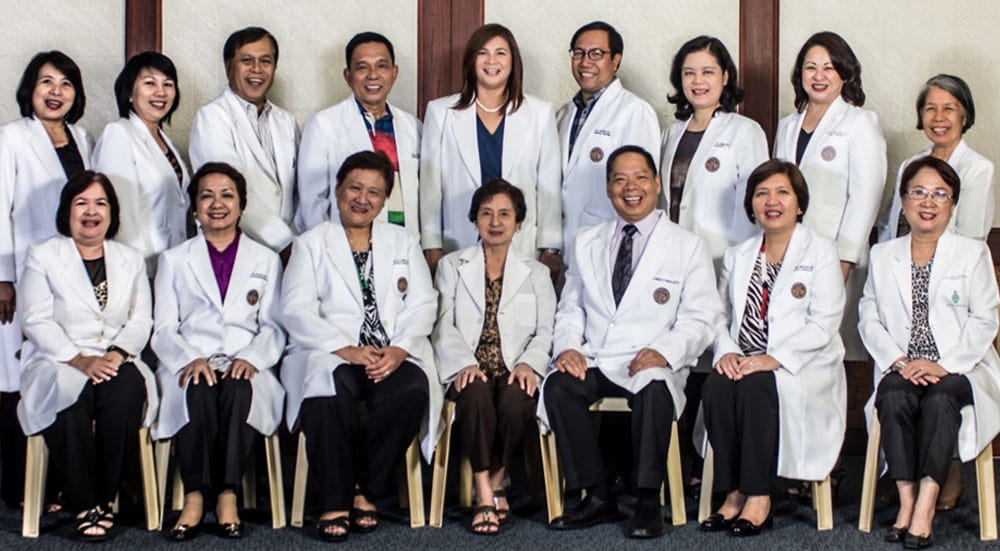
DEPARTMENT OF PREVENTIVE, FAMILY, AND COMMUNITY MEDICINE
Preventive, Family and Community Medicine I
The freshmen course aims to make the students understand the factors involved in health promotion (health education, disease prevention and health protection) in context of the individual, family unit and the community at large.
• Family and Community Health I focuses on the family unit as a very important resource in health promotion with emphasis on disease prevention and health maintenance. Wellness achieved through health education is an integral part of the module.
- Epidemiology and Population Dynamics present the basic concepts and principles on the prevention and control of communicable and degenerative diseases and the effects of uncontrolled or unregulated population on the state of health and disease.
- Health Statistics discusses the collection, organization, presentation and analysis of statistical data pertaining to health and disease and the role of descriptive and inferential statistics in research.
- Research I handles generalities in doing clinical research and its role and relevance in better health care provision and clinical practice.
Teaching strategies consist of lectures and correlates, small group discussions and tutorials, skills laboratories and workshops.
Preventive, Family and Community Medicine II
The sophomore course includes the following modules:
- Family and Community Health II focuses on the community as a very important resource in health promotion with emphasis on disease prevention and health maintenance. Community health development and community diagnosis is an integral part of the module.
- Research II (Evidence-Based Medicine and Critical Appraisal). The students will be introduced to the concepts of evidence-based medicine with application of principles through critical appraisal of scientific literature and clinical practice guidelines.
- Occupational Health involves discussion by the faculty and students of health and safety issues in the work place and industries, including prevention and control of industrial hazards.•Medical Sociology involves the study of Filipino family beliefs, customs and practices and how they affect individuals and communities with accent on sociology of medical practice.
- Human Ecology and Environmental Sanitation present the environment, physical, biological and socio-economic factors that affect health and disease with coverage on control of environmental factors such as water, sewage, insects and rodents responsible for disease transmission.
Teaching strategies consist of lectures and correlates, small group discussions and tutorials, skills laboratories and workshops, individual work and group presentations.
Preventive, Family and Community Medicine III
The third-year course aims to impart knowledge to students, reinforce their skills and develop the right attitude towards health issues in the following areas:
- Family and Community Health III focuses on the concepts and impact of illness on individuals, families and communities. The biopsychosocial approach principles and concepts are reviewed and applied in this module. Likewise, traditional, alternative and integrative medicine approaches are explored.
- Public Health Administration presents the principle of organization/management in health settings, health care delivery systems, key health legislations and rules and regulations that are important for future medical practice. The national health situation is highlighted as well.
- Applied Epidemiology deals with the practical application of principles and concepts in prevention and control of endemic and prevalent communicable diseases and degenerative or lifestyle diseases. Teaching strategies consist of lecture-discussion, field visits, seminar-workshops, individual work and group presentations.
Preventive, Family and Community Medicine IV (Clinical Clerkship in Preventive, Family and Community Medicine)
The medical senior realizes the importance of the family, the immediate environment and the community as they affect people in health and disease. He takes on the different roles of the 5-star physician: Educator, Healer, Administrator/Leader, Social Mobilizer and Researcher. This four (4) weeks rotation aims to develop in medical seniors the competence required for health management in a primary care setting: community diagnosis; health program prioritization, planning, and implementation; health activity evaluation and monitoring. Medical seniors do actual community work that is related to the implementation of public health programs through Primary Health Care approaches. Their regular activities include: health education and training; service provision including primary care clinics; vaccination/immunization; nutrition and weight management; family and home visitations; and research.
Family Medicine (Electives)
The Family Medicine rotation through its Family Health Care Program (FHCP) offers a traditional family practice of caring for patients and their families over a period of time, both in sickness and in health, in a comprehensive and personalized manner. The course addresses the human dimension of the patient-physician-family relationship, which is essential to a future physician’s education. It aims to develop a complete physician with greater social awareness and competency in primary care: a health educator, a researcher, and an administrator. Its emphasis is on family dynamics, family life cycle, impact of illness on the family, tools for family assessment and doctor-patient relationship. It utilizes lectures, case discussion and role-playing as teaching strategies. A Family Case Presentation serves as the culminating activity of their rotation. (This is a one-week module given to interested medical seniors under the elective rotation choices.)
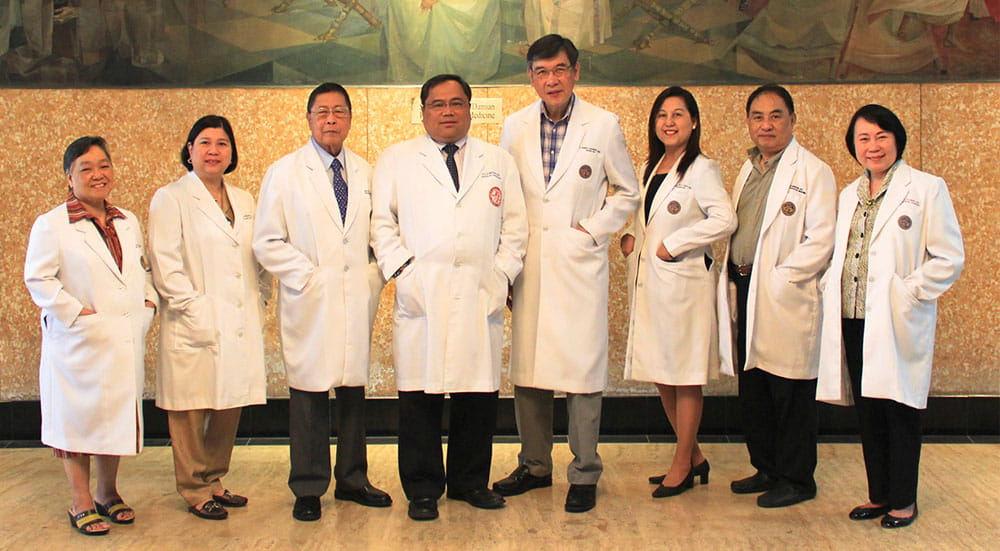
DEPARTMENT OF RADIOLOGY
The objective of the course is to offer basic knowledge of Radiology and its sub-specialties and to help students learn the judicious use of diagnostic imaging in clinical medicine. Special emphasis is placed on commonly encountered diseases in the local setting.
The course consists of general lectures, classroom group discussions, case presentation sessions, and an exhibit of clinical images. It is presented in 7 modules integrating the different sub-specialties in Radiology: Principles and Techniques; Chest; Abdomen; Gastrointestinal Tract, Retroperitoneum, Genitourinary Tract, Neuroradiology, Musculoskeletal System, and special lectures (Pediatric Radiology, Breast, Radiation Oncology and Nuclear Medicine).
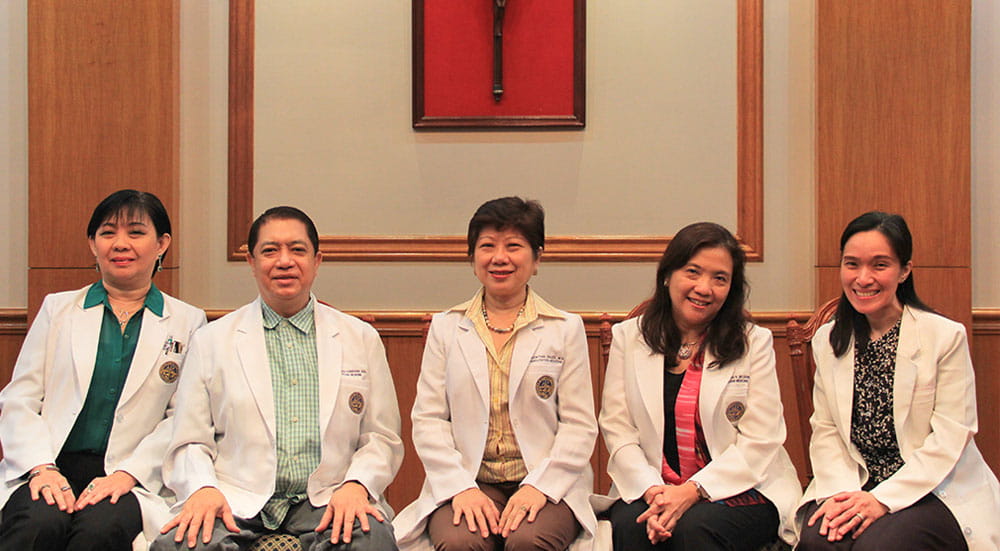
DEPARTMENT OF REHABILITATION MEDICINE
The course aims to make the students know the role of rehabilitation medicine in the comprehensive management of patients with neuromuscular, musculo-skeletal, and cardiopulmunary dysfunction both in acute and chronic stage of impairment. The students are trained to be able to conduct a comprehensive evaluation of the functional level and capacity of patients with disabilities; recognize the physical, psychological, social and emotional factors comprising the “Syndrome” of the disabled patients: know the various modalities and assistive appliances employed in the management of rehabilitative conditions; and outline the basic needs of patients with disabilities.
Teaching strategies consist of formal lectures, demonstrations and discussions with audiovisual aid. The course is given to third year medical students two hours a week for one quarter or a total of 17 hours per quarter.
Clinical Clerkship in Rehabilitation Medicine
Clinical Clerkship rotation in the Rehabilitation Ward aims to make the medical seniors participate in ward rounds, take care of assigned rehabilitation medicine patients, accomplished histories and physical examination and discharge summaries, evaluate functional status, outline rehabilitation programs, follow-up work ups, attend clinical lectures and grand rounds, and participate in the Journal Club. The course is given during a one week rotation.
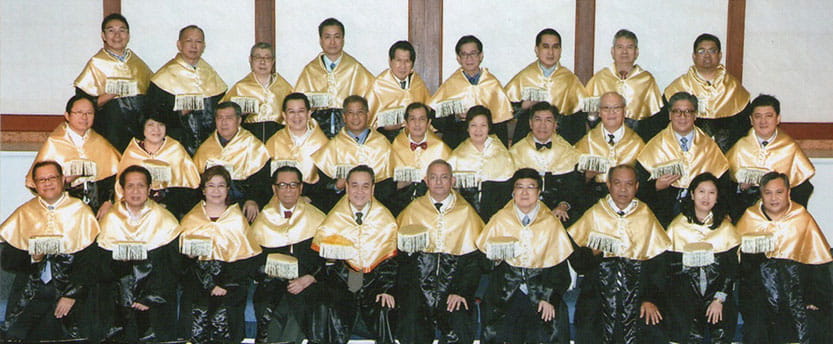
DEPARTMENT OF SURGERY
Surgery I
The aim of the course is to introduce to the students the basic principles of Surgery as a preparation for further studies in Clinical Surgery. It includes Principles of Surgery, Minor Surgery, and Basic Skills in Surgery. The teaching-learning strategies are general lectures, small-group case discussions, and skills demonstrations and an Objective Structured Evaluation of must-know skills such as scrubbing, gowning, gloving, the use of surgical instruments and the performance of basic surgical procedures. The course is offered to second year medical students in a semester, 6 hours a week for a total of 102 hours.
Surgery II
This is a yearly subject designed to equip the students with the basic knowledge of Clinical Surgery that will serve as his foundation in future general practice. Such foundation not only includes theoretical knowledge but likewise dwell on ethical and practical applications relevant to the times and local situations. The emphasis is on General Surgery, however, common problems encountered in other surgical specialties are also taken up. These are Urological Surgery, Orthopedic Surgery, Cardiovascular and Thoracic Surgery, Neurological Surgery, Pediatric Surgery, and Plastic and Reconstructive Surgery. Aside from the lectures and small group discussions, the students begin to enjoy the exposure to surgical patients in the hospital for clinical correlation and as a preview to surgical clerkship. This is a yearly course offered to third year medical students 6 ½ hours a week for a total of 260 hours.
Surgery III
Clerkship in Surgery is a 2-month rotation in the Hospital where the fourth year students become part of the surgical team and personally handle patients. They learn to solve surgical problems, develop clinical judgment and perform psychomotor skills through guided and supervised patient care. Integral to these is the Holistic approach to the patient whereby Compassion and Ethical behavior are emphasized. Conferences, Bedside Teaching, and Grand Rounds are activities where students can avail of the expertise and experience of the Consultant and Resident Staff. The requirements in the rotation include passing the mini-revalida and the performance of identified basic surgical procedures.

